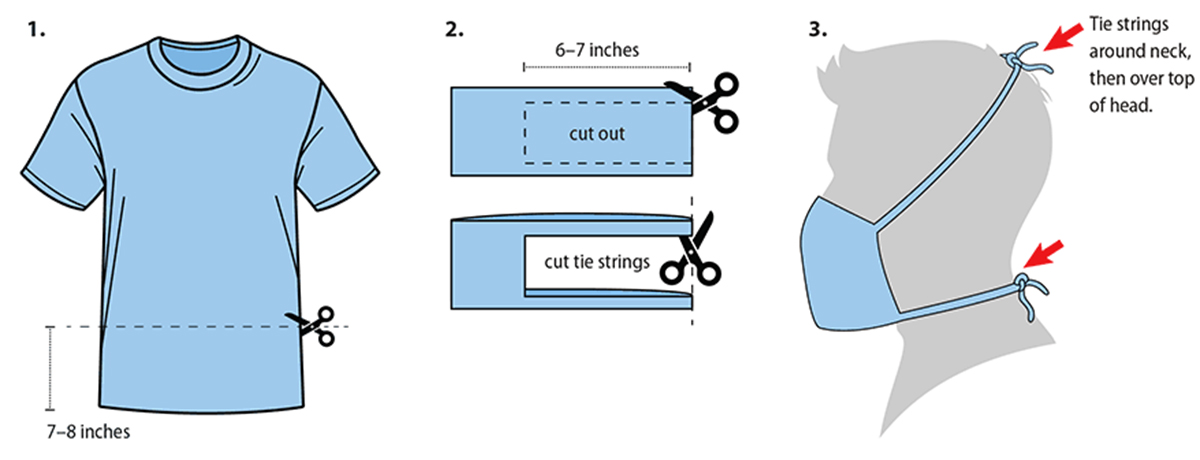Recently, the Center for Disease Control and Prevention (the CDC) has now advised that everyone should be wearing a face mask when out in public. Even if you do not show any symptoms or have been exposed to an infected person, the CDC recommends that you should still wear a face mask in public settings. This is to help slow the spread of the virus and help people who may have the virus and do not know it (since sometimes symptoms may not show).
With the recent shortage of face masks available in stores, people are now creating their own DIY face masks at home by sewing some fabric together that’s effective against the coronavirus. For a face mask pattern, the CDC has an informative tutorial on how to sew cloth to create a face mask.
If you don’t know how to sew (like myself, haha), we listed 2 different face masks DIY projects that do not include any type of sewing! These no-sew face mask DIYs require materials you can find at home — so you don’t need to go out to the store. The materials that you need is a bandana and/or t-shirt and some rubber bands – no sewing or glue required.
Easy Face Mask DIY (Using 2 Items)
YouTuber Kristin Omdalh recently uploaded a no-sew bandana face mask video with the step-by-step process of the DIY project – which you can review below:
At NYFifth.com, we have a variety of bandanas available in a variety of colors! Here are some bandanas for sale:
- Port Authority C842 – Bandana
- Big Accessories BA001 – Solid Color Bandana
- Liberty Bags PSB2121 – Sublimation Triangle Bandana
Don’t have a bandana at home nor do you want to purchase one? For the face mask fabric you can use any piece of cotton fabric and follow the same DIY face mask tutorial. A standard bandana size is 22” square (or 56 square centimeters). Some recommended materials you may have at home that you can use are old t-shirts, pillow cases, bed sheets or pajamas that you no longer use.
T-Shirt Face Mask DIY
The CDC also provided an easy t-shirt face mask DIY if you do not have any rubber bands or hair ties available. This DIY face mask only requires a t-shirt and some scissors to cut the shirt. You can follow this t-shirt face mask guide below:

Remember when creating your own face masks, the face masks should:
- Fit snugly against the side of your face,
- Be secured with ties or ear loops,
- Include multiple layers of fabric, and
- Allows for easy breathing without restriction.
These fabric face masks are also reusable as you can put them in the washer (with hot water).
Please note that these DIY face masks are ideal for those running errands and going out in public. This DIY face mask is not ideal for those working in the hospital or health care facility dealing with patients with COVID-19, as these face masks still can let tiny droplets seep through parts of the mask. These droplets come from those who are coughing and/or sneezing who may have the virus. If you are too close, you can still breathe in these droplets — which is one of the ways the disease spreads.
If you’re looking to purchase already-made face masks in bulk for your team or donate to a hospital or health care facility, we have some face masks for sale that can be purchased in bulk quantities:
- Tultex FM19 – Face Mask (10 pc minimum order, 200 pc case quantity)
- Bella+Canvas BST323 – Guard Facemask (120 pc minimum order)
It’s important to safely remove your mask when you’re done using it. You should carefully remove it from the bands and do NOT touch the front of the mask. Make sure try not to touch your mouth, eyes and nose when removing and to properly wash your hands immediately afterwards. The WHO (World Health Organization) suggest to wash your hands regularly for 20 seconds with soap and water or alcohol-based hand rub.
Wearing a face mask is just one out of the many steps you need to do to help prevent the spread of the virus. Remember to wash your hands regularly and try to avoid going out unless necessary. When going out, please use face masks and keep a distance of 6 feet from another person. When done with the masks, safely remove the mask, properly wash your hands right after and wash your mask.
Follow all state and local protocol and try to avoid going outside unless it’s absolutely needed. Stay home = saving lives. For more up-to-date information and cornovairus tips to keep you safe, you can visit the WHO website and your state and local government website.
From the NYFifth Team — please stay safe!!